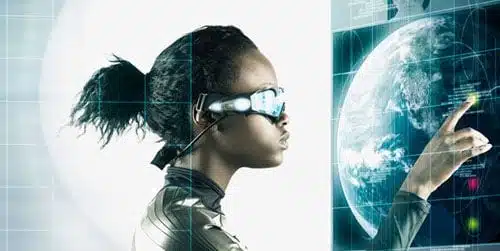
The Science Channel’s new series, Prophets of Science Fiction, argues that great science fiction writers, from H.G. Wells to Philip K. Dick, Arthur C. Clarke to Isaac Asimov, have a special talent for divining the shape of the future from seeds — ideas, technologies — that exist today. Like many prophecies, the show overreaches a little and tends to vague details, but it also offers means with which to think about what lies ahead.
The series premiere, airing on 9 November, looks at Mary Shelley, whose Frankenstein or, The Modern Prometheus, published anonymously in 1818, spawned the sci-fi genre. A plot summary of the book is interwoven with Shelley’s biography; the show submits that her novel presaged organ transplants and advanced prosthetics. That seems plausible, though stretching the definition of “prophecy” too far makes the word meaningless. And when Shelley is presented as “predicting” bioengineering, in-vitro fertilization, and computer brains, that word too starts to seem like gracious overstatement.
A more nuanced definition of “science fiction” leaves out the prophetic act and is offered by Shelley biographer Anne Mellor. She describes Frankenstein as a plausible account of the science of the day, combined with a humanistic critic of that science, and a viable prediction what would happen if the ways of science and technology are not controlled. Shelley drew on the science of her time, including the work of Italian physicist Luigi Galvani, who’d applied electricity to frogs, making their muscles jump and twitch. The practice of using cadavers for medical research also inspired the figure of Dr. Frankenstein, who, despite the later movie portrayals, didn’t use lightning to re-animate his creature.
It’s in the critique of this science that Shelley’s tale gains its power. It indicts the urge of man to play god by revealing his incapacity to do so: the good doctor winds up using large cadavers and animal parts because he lacks the tools and knowledge to build a more recognizably human figure. From the beginning, his project is flawed, monstrous. The show connects this to Shelley’s commitment to two philosophical traditions, Romanticism and (which doubted claims of “progress”) and the Enlightenment (whose followers placed their faith in man’s continual self-improvement).
Shelley not only recognized this slit (which still many of our debates about science), but also gave it memorable form in the character of Dr. Frankenstein. She saw as well that science maintains its own metaphors, its useful fictions. In her time, the vision of man as machine, a system of interconnected parts, was beginning to emerge. In her introduction to Frankenstein‘s second edition, she writes,
I saw the hideous phantasm of a man stretched out, and then, on the working of some powerful engine, show signs of life and stir with an uneasy, half-vital motion. Frightful must it be, for supremely frightful would be the effect of any human endeavour to mock the stupendous mechanism of the Creator of the world.
The program suggests that if the body is a machine — even it’s first built by God — then parts-swapping makes logical sense, as does a new machine built from leftovers. Genetic engineering fits this worldview: it’s simply tinkering on a smaller scale. The Human Genome Project is an attempt to understand all the parts of the machine. And if the body is already a machine, why not enhance it with better, more capable machinery: that way lies prosthetics and, of course, cyborgs. Who’s to say that our machines need be physical at all? We can recreate mental machinery as bits of data, strings of information; constructed correctly, this machinery can avoid the pitfalls of our soggy, fallible brains.
This is the progressive impulse Shelley identified, the Enlightenment project that sought to separate man from nature through knowledge. Knowledge offered choice, control, and power. According to Prophets of Science Fiction, Mary Shelley’s critique gains power by locating both Romantic and Enlightenment ideals in the form of Dr. Frankenstein, the would-be creator who can’t escape his all-too-human nature. He brings his creature to life, but can’t bear to look into its yellowed, living-dead eyes. He abandons the monster, who then — again, all-too-humanly — exacts his revenge.
Does this tale of a modern Prometheus, a failed creator, really predict designer babies? Only in the broadest sense. More precisely, Prophets of Science Fiction asserts, it predicts the conflicted reactions of those of us still grappling with the Romantic/Enlightenment dichotomy. Our suspicions regarding frankensbabies, frankenfood, etc., etc., reveal the archetypal power of Shelley’s novel, where hope for progress and fear of change cannot be separated
